微观经济学 第四章(曼昆)
- 格式:ppt
- 大小:1.39 MB
- 文档页数:72
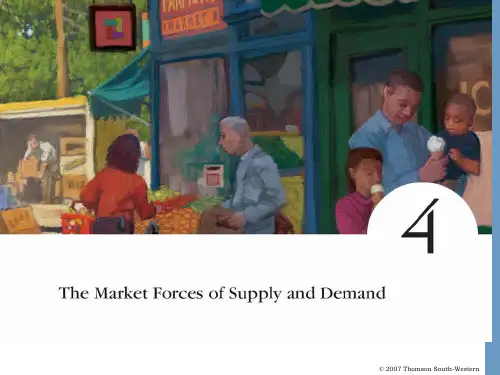
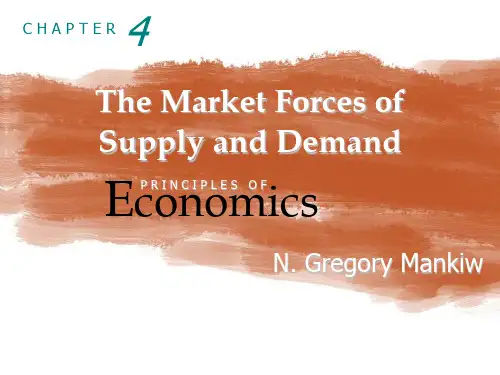
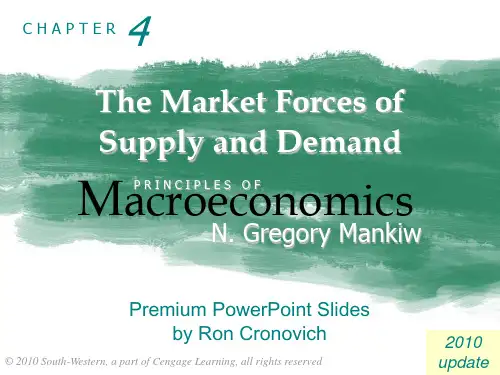
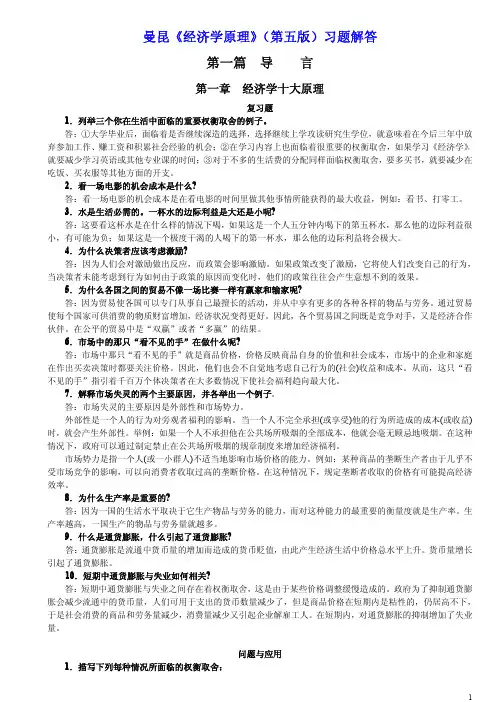
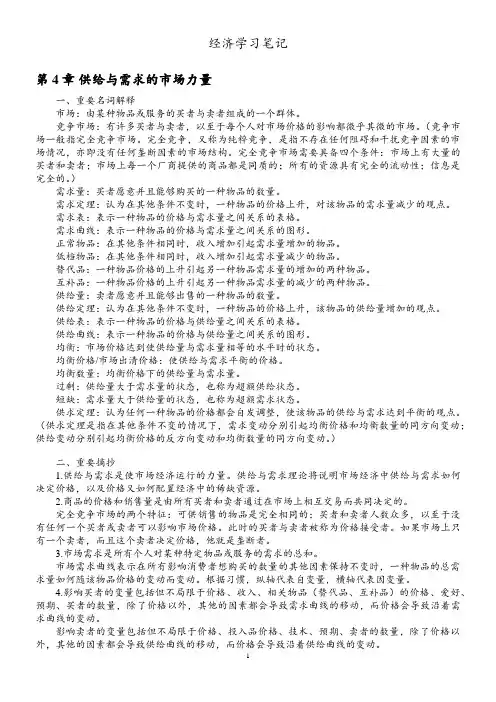
经济学习笔记第4章供给与需求的市场力量一、重要名词解释市场:由某种物品或服务的买者与卖者组成的一个群体。
竞争市场:有许多买者与卖者,以至于每个人对市场价格的影响都微乎其微的市场。
(竞争市场一般指完全竞争市场。
完全竞争,又称为纯粹竞争,是指不存在任何阻碍和干扰竞争因素的市场情况,亦即没有任何垄断因素的市场结构。
完全竞争市场需要具备四个条件:市场上有大量的买者和卖者;市场上每一个厂商提供的商品都是同质的;所有的资源具有完全的流动性;信息是完全的。
)需求量:买者愿意并且能够购买的一种物品的数量。
需求定理:认为在其他条件不变时,一种物品的价格上升,对该物品的需求量减少的观点。
需求表:表示一种物品的价格与需求量之间关系的表格。
需求曲线:表示一种物品的价格与需求量之间关系的图形。
正常物品:在其他条件相同时,收入增加引起需求量增加的物品。
低档物品:在其他条件相同时,收入增加引起需求量减少的物品。
替代品:一种物品价格的上升引起另一种物品需求量的增加的两种物品。
互补品:一种物品价格的上升引起另一种物品需求量的减少的两种物品。
供给量:卖者愿意并且能够出售的一种物品的数量。
供给定理:认为在其他条件不变时,一种物品的价格上升,该物品的供给量增加的观点。
供给表:表示一种物品的价格与供给量之间关系的表格。
供给曲线:表示一种物品的价格与供给量之间关系的图形。
均衡:市场价格达到使供给量与需求量相等的水平时的状态。
均衡价格/市场出清价格:使供给与需求平衡的价格。
均衡数量:均衡价格下的供给量与需求量。
过剩:供给量大于需求量的状态,也称为超额供给状态。
短缺:需求量大于供给量的状态,也称为超额需求状态。
供求定理:认为任何一种物品的价格都会自发调整,使该物品的供给与需求达到平衡的观点。
(供求定理是指在其他条件不变的情况下,需求变动分别引起均衡价格和均衡数量的同方向变动;供给变动分别引起均衡价格的反方向变动和均衡数量的同方向变动。
)二、重要摘抄1.供给与需求是使市场经济运行的力量。
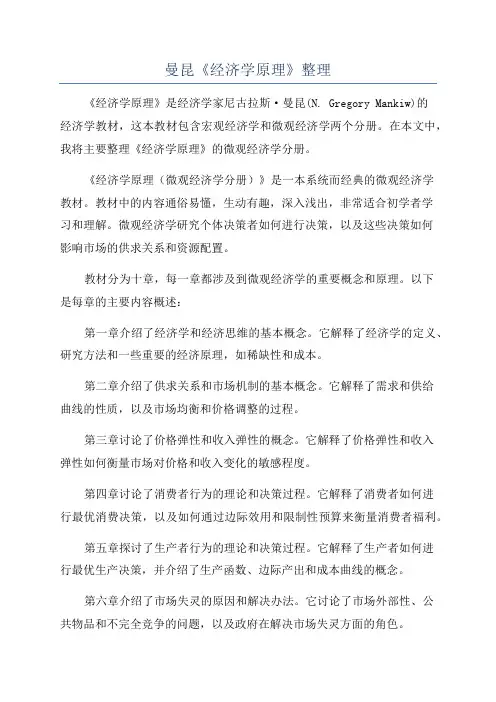
曼昆《经济学原理》整理《经济学原理》是经济学家尼古拉斯·曼昆(N. Gregory Mankiw)的经济学教材,这本教材包含宏观经济学和微观经济学两个分册。
在本文中,我将主要整理《经济学原理》的微观经济学分册。
《经济学原理(微观经济学分册)》是一本系统而经典的微观经济学教材。
教材中的内容通俗易懂,生动有趣,深入浅出,非常适合初学者学习和理解。
微观经济学研究个体决策者如何进行决策,以及这些决策如何影响市场的供求关系和资源配置。
教材分为十章,每一章都涉及到微观经济学的重要概念和原理。
以下是每章的主要内容概述:第一章介绍了经济学和经济思维的基本概念。
它解释了经济学的定义、研究方法和一些重要的经济原理,如稀缺性和成本。
第二章介绍了供求关系和市场机制的基本概念。
它解释了需求和供给曲线的性质,以及市场均衡和价格调整的过程。
第三章讨论了价格弹性和收入弹性的概念。
它解释了价格弹性和收入弹性如何衡量市场对价格和收入变化的敏感程度。
第四章讨论了消费者行为的理论和决策过程。
它解释了消费者如何进行最优消费决策,以及如何通过边际效用和限制性预算来衡量消费者福利。
第五章探讨了生产者行为的理论和决策过程。
它解释了生产者如何进行最优生产决策,并介绍了生产函数、边际产出和成本曲线的概念。
第六章介绍了市场失灵的原因和解决办法。
它讨论了市场外部性、公共物品和不完全竞争的问题,以及政府在解决市场失灵方面的角色。
第七章讨论了消费者剩余和生产者剩余的概念。
它解释了消费者剩余和生产者剩余如何衡量买家和卖家对交易的满意程度。
第八章讨论了纳什均衡和博弈理论的概念。
它解释了博弈理论如何帮助我们理解决策者之间的相互作用和策略选择。
第九章介绍了垄断和垄断竞争的市场结构。
它解释了垄断者如何通过价格和产量限制来影响市场,并讨论了垄断竞争下的市场行为。
第十章介绍了资源市场的概念和原理。
它解释了劳动市场和资本市场如何确定工资和利率,并讨论了市场竞争对工资和利率的影响。

曼昆微观经济学
穆曼昆(Mankiw)微观经济学是从市场经济体系出发,以少量理论建构而构筑起来的关
于经济运作基础的科学理论,微观经济学还涵盖和分析关于家庭和经济主体应对市场的不
断变化的行为和策略的研究内容。
穆曼昆的微观经济学是对家庭、公司和政府等经济主体
的行为和决策进行系统分析和梳理,从而了解其在市场环境下是如何运作、发展和影响整
个经济体系的。
穆曼昆微观经济学是建立在传统的几个核心理论框架之上的,其中包括供需、税收、
货币及实物的经济均衡理论,以及家庭、企业消费行为的定向、期望理论。
依照这些理论,穆曼昆提出了可能影响个体行为的供给和需求因素,一是各作“外部环境因素”,如税收、货币供应和利率政策;二是作“内部环境因素”,即家庭、企业内部结构、家庭预算收入、期望价格等。
针对家庭和公司,依据是否面临均等价格,穆曼昆微观经济学分别提出了均等价格和
非均等价格的经济行为分析结果,从而精确分析出这两者行为的差异,进而提出了有效的
应对策略,使家庭和公司都能获得最优的受益结果。
依据此,穆曼昆的微观经济学不仅对
于家庭的生活决策有较大的帮助,而且也能使政府保持经济稳定,同时为社会的和谐运行
提供有效的保障。
总而言之,穆曼昆的微观经济学不仅是市场经济体系中重要的理论框架,更是当代经
济阶段的核心理念,它提供了个体和政府在市场机制下对准则行市场行为的重要指导,为
政府提出有效的技术政策提供了有效的科学依据,从而最大限度地保护国民的经济利益。
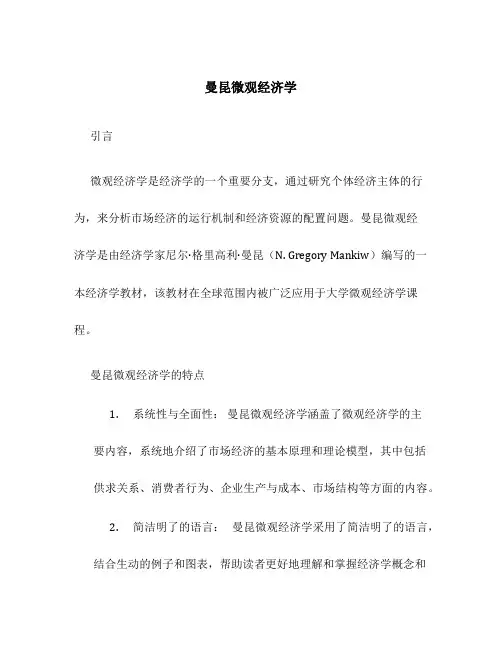
曼昆微观经济学引言微观经济学是经济学的一个重要分支,通过研究个体经济主体的行为,来分析市场经济的运行机制和经济资源的配置问题。
曼昆微观经济学是由经济学家尼尔·格里高利·曼昆(N. Gregory Mankiw)编写的一本经济学教材,该教材在全球范围内被广泛应用于大学微观经济学课程。
曼昆微观经济学的特点1.系统性与全面性:曼昆微观经济学涵盖了微观经济学的主要内容,系统地介绍了市场经济的基本原理和理论模型,其中包括供求关系、消费者行为、企业生产与成本、市场结构等方面的内容。
2.简洁明了的语言:曼昆微观经济学采用了简洁明了的语言,结合生动的例子和图表,帮助读者更好地理解和掌握经济学概念和分析方法。
这种语言风格极大地降低了对数学知识和经济学背景的要求,使得本教材更加适合广大读者阅读。
3.深度剖析经济现象:在曼昆微观经济学中,作者不仅仅介绍经济学的基本概念和理论,更重要的是深入剖析经济现象背后的原因和机制,通过经济学分析和演绎,揭示了经济活动的本质和规律性。
4.与现实经济联系紧密:曼昆微观经济学将经济学的理论与现实经济紧密联系在一起,通过真实案例和实证研究,解释了经济学理论模型在实际经济中的应用和局限性。
同时,也加入了当前社会经济热点问题的分析和讨论,使得读者可以将经济学知识与现实经济现象相结合,更好地理解并应用经济学的原理和方法。
曼昆微观经济学的主要章节第一章:引言本章主要介绍了微观经济学的研究对象和方法,阐述了经济学的基本原理和假设。
第二章:供求关系本章介绍了市场经济中的供给和需求关系,包括供给曲线和需求曲线的形成和变动,并讨论了市场均衡和价格调整的过程。
第三章:消费者行为本章详细介绍了消费者的效用理论,讨论了消费者的预算约束和消费的最优选择问题,同时还分析了不同市场条件下消费者需求的弹性。
第四章:企业生产与成本本章探讨了企业的生产过程和生产函数,解释了企业的边际成本和平均成本概念,以及企业的最优产量和成本分布问题。

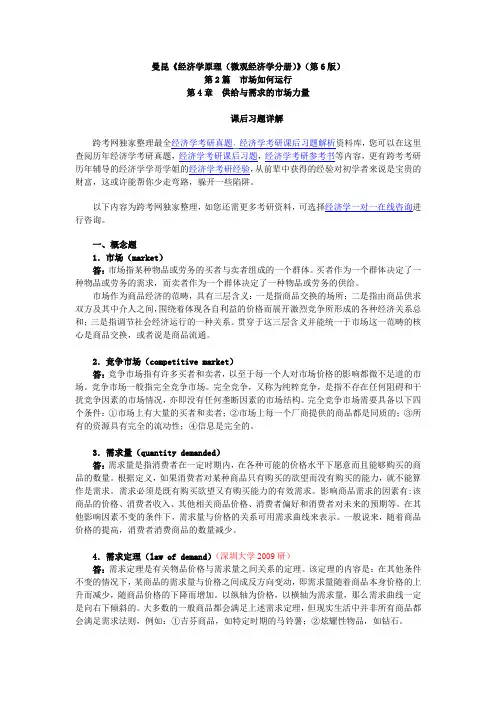
曼昆《经济学原理(微观经济学分册)》(第6版)第2篇市场如何运行第4章供给与需求的市场力量课后习题详解跨考网独家整理最全经济学考研真题,经济学考研课后习题解析资料库,您可以在这里查阅历年经济学考研真题,经济学考研课后习题,经济学考研参考书等内容,更有跨考考研历年辅导的经济学学哥学姐的经济学考研经验,从前辈中获得的经验对初学者来说是宝贵的财富,这或许能帮你少走弯路,躲开一些陷阱。
以下内容为跨考网独家整理,如您还需更多考研资料,可选择经济学一对一在线咨询进行咨询。
一、概念题1.市场(market)答:市场指某种物品或劳务的买者与卖者组成的一个群体。
买者作为一个群体决定了一种物品或劳务的需求,而卖者作为一个群体决定了一种物品或劳务的供给。
市场作为商品经济的范畴,具有三层含义:一是指商品交换的场所;二是指由商品供求双方及其中介人之间,围绕着体现各自利益的价格而展开激烈竞争所形成的各种经济关系总和;三是指调节社会经济运行的一种关系。
贯穿于这三层含义并能统一于市场这一范畴的核心是商品交换,或者说是商品流通。
2.竞争市场(competitive market)答:竞争市场指有许多买者和卖者,以至于每一个人对市场价格的影响都微不足道的市场。
竞争市场一般指完全竞争市场。
完全竞争,又称为纯粹竞争,是指不存在任何阻碍和干扰竞争因素的市场情况,亦即没有任何垄断因素的市场结构。
完全竞争市场需要具备以下四个条件:①市场上有大量的买者和卖者;②市场上每一个厂商提供的商品都是同质的;③所有的资源具有完全的流动性;④信息是完全的。
3.需求量(quantity demanded)答:需求量是指消费者在一定时期内,在各种可能的价格水平下愿意而且能够购买的商品的数量。
根据定义,如果消费者对某种商品只有购买的欲望而没有购买的能力,就不能算作是需求。
需求必须是既有购买欲望又有购买能力的有效需求。
影响商品需求的因素有:该商品的价格、消费者收入、其他相关商品价格、消费者偏好和消费者对未来的预期等。
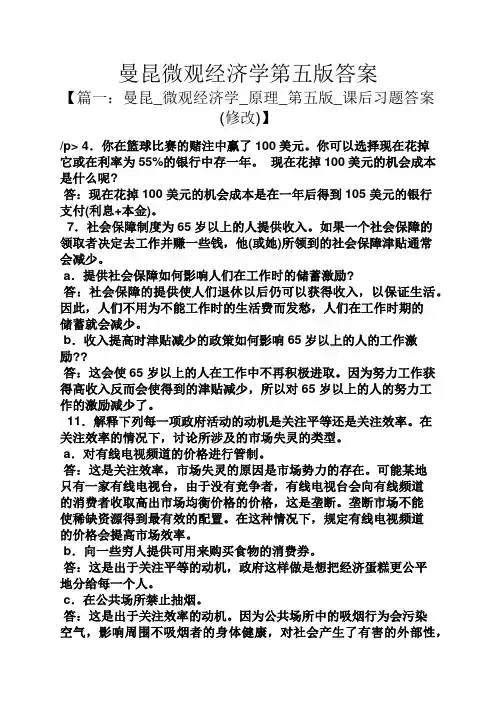
曼昆微观经济学第五版答案【篇一:曼昆_微观经济学_原理_第五版_课后习题答案(修改)】/p> 4.你在篮球比赛的赌注中赢了100美元。
你可以选择现在花掉它或在利率为55%的银行中存一年。
现在花掉100美元的机会成本是什么呢?答:现在花掉100 美元的机会成本是在一年后得到105 美元的银行支付(利息+本金)。
7.社会保障制度为65岁以上的人提供收入。
如果一个社会保障的领取者决定去工作并赚一些钱,他(或她)所领到的社会保障津贴通常会减少。
a.提供社会保障如何影响人们在工作时的储蓄激励?答:社会保障的提供使人们退休以后仍可以获得收入,以保证生活。
因此,人们不用为不能工作时的生活费而发愁,人们在工作时期的储蓄就会减少。
b.收入提高时津贴减少的政策如何影响65岁以上的人的工作激励??答:这会使65 岁以上的人在工作中不再积极进取。
因为努力工作获得高收入反而会使得到的津贴减少,所以对65 岁以上的人的努力工作的激励减少了。
11.解释下列每一项政府活动的动机是关注平等还是关注效率。
在关注效率的情况下,讨论所涉及的市场失灵的类型。
a.对有线电视频道的价格进行管制。
答:这是关注效率,市场失灵的原因是市场势力的存在。
可能某地只有一家有线电视台,由于没有竞争者,有线电视台会向有线频道的消费者收取高出市场均衡价格的价格,这是垄断。
垄断市场不能使稀缺资源得到最有效的配置。
在这种情况下,规定有线电视频道的价格会提高市场效率。
b.向一些穷人提供可用来购买食物的消费券。
答:这是出于关注平等的动机,政府这样做是想把经济蛋糕更公平地分给每一个人。
c.在公共场所禁止抽烟。
答:这是出于关注效率的动机。
因为公共场所中的吸烟行为会污染空气,影响周围不吸烟者的身体健康,对社会产生了有害的外部性,而外部性正是市场失灵的一种情况,而这也正是政府在公共场所禁止吸烟的原因。
d.把美孚石油公司(它曾拥90%的炼油厂)分拆为几个较小的公司。
答:出于关注效率的动机,市场失灵是由于市场势力。
第二篇市场如何运作第四章供给与需求的市场力量复习题1.什么是竞争市场?简单描述除了完全竞争市场之外的市场类型。
答:竞争市场是有许多买者与卖者,以至于每个人对市场价格的影响都微乎其微的市场。
除了完全竞争市场之外,还有垄断市场。
在这个市场上只有一个卖者,他决定价格。
这个卖者被称为垄断者。
还有寡头市场,在这个市场上有几个并不总是主动竞争的卖者,他们提供相似或相同的产品。
通常情况下,寡头们会尽力联合起来,避免激烈的竞争,收取较高的市场价格。
还有垄断竞争市场,这是一个有许多提供相似但不相同产品的企业的市场结构。
由于各自提供的产品不同,每个企业对产品的价格都有一定的影响力。
2.什么是需求表和需求曲线?它们如何相关联?为什么需求曲线向右下方倾斜?答:需求表是表示一种物品价格与需求量之间关系的表格,需求曲线是表示一种物品价格与需求量之间关系的图形。
需求曲线将需求表用图形的形式表现出来,需求表是需求曲线上若干个点的坐标的数字表格排列。
需求曲线向右下方倾斜是因为在其他条件不变的情况下,随着价格上升,需求量会减少。
3.消费者嗜好的变化引起了沿着需求曲线的变动,还是需求曲线的移动,价格的变化引起了沿着需求曲线的变动,还是需求曲线的移动?答:消费者嗜好的变化引起了需求曲线的移动,价格的变化引起了沿着需求曲线的变动。
4.Popeye的收入减少了,结果他买了更多的菠菜。
菠菜是低档物品,还是正常物品? Popeye菠菜的需求曲线是什么样的?答:菠菜对波匹来说是低档物品。
因为Popeye的收入减少了,他对菠菜的需求量反而增大。
波匹菠菜的需求曲线是向右下方倾斜的。
5.什么是供给表和供给曲线,它们如何关联?为什么供给曲线向石上方倾斜?答:供给表是表示一种物品价格与供给量之间关系的表格,供给曲线是表示一种物品价格与供给量之间关系的图形。
供给曲线是供给表的图形表示,供给表是供给曲线上点的坐标的数字排列。
因为在其他因素不变时,价格上升,供给量上升,所以供给曲线向右上方倾斜。
Ch04 经济增长1一、名词解释索洛增长模型稳定状态资本的黄金规则水平二、选择题1.下面关于资本的边际产量MPK的哪些说法是错误的()A.MPK = f(k + 1) - f(k) B.MPK随K增加而减少C.当资本量低时,MPK很小D.MPK等于生产函数y = f(k)的斜率。
2.如果资本可平均使用50年,那么折旧率为():A.50%,或每年0.5 B.0.5%,或每年0.005C.2%,或每年0.02 D.0.02%,或0.00023.如果生产函数Y = F(K, L)为规模收益不变,那么():A.F(zK, zL) = zY B.F(K/L, 1) = Y/LC.y = f(k), y为每个工人的产出,k为每个工人的资本量D.以上都对4.如果y = k1/2, s = 0.4,折旧率d = 20%,那么稳定状态的人均资本水平为()A.4 B.8 C.2 D.25.资本的黄金规则水平是()的最大化A.人均消费水平B.人均产出C.人均消费增长率D.人均产出增长率6.一个初始处于稳定状态的经济提高储蓄率,到达新的稳定状态后()A.人均产出增长更快于以前B.人均产出水平高于以前C.人均资本不变D.以上都对三、问答题1.为什么一个经济决策者会选择黄金规则的资本水平?2.决策者会选择其资本高于黄金规则稳定状态的稳定状态吗?会选择其资本低于黄金规则稳定状态的稳定状态吗?解释之。
3.1983年的《总统经济报告》包括了下面这样一段话:“把较大比例的国民产出用于投资将有助于迅速恢复生产率增长,并提高生活水平。
”你同意这种主张吗?并解释之。
4.在索洛模型中,储蓄率如何影响稳定状态的收入水平?它如何影响稳定状态的增长率?5.一种消费函数的观点是,工人边际消费倾向高,而资本家边际消费倾向低。
为了说明这种观点的含义,假设一个经济所有的工资收入都用于消费,而所有资本收入都用于储蓄。
说明,如果生产要素赚到了自己的边际产量,这个经济就达到了黄金规则的资本水平。
第一章问题与应用4.你在篮球比赛的赌注中赢了100美元。
你可以选择现在花掉它或在利率为55%的银行中存一年。
现在花掉100美元的机会成本是什么呢?答:现在花掉100 美元的机会成本是在一年后得到105 美元的银行支付(利息+本金)。
7.社会保障制度为65岁以上的人提供收入。
如果一个社会保障的领取者决定去工作并赚一些钱,他(或她)所领到的社会保障津贴通常会减少。
A.提供社会保障如何影响人们在工作时的储蓄激励?答:社会保障的提供使人们退休以后仍可以获得收入,以保证生活。
因此,人们不用为不能工作时的生活费而发愁,人们在工作时期的储蓄就会减少。
B.收入提高时津贴减少的政策如何影响65岁以上的人的工作激励??答:这会使65 岁以上的人在工作中不再积极进取。
因为努力工作获得高收入反而会使得到的津贴减少,所以对65 岁以上的人的努力工作的激励减少了。
11.解释下列每一项政府活动的动机是关注平等还是关注效率。
在关注效率的情况下,讨论所涉及的市场失灵的类型。
A.对有线电视频道的价格进行管制。
答:这是关注效率,市场失灵的原因是市场势力的存在。
可能某地只有一家有线电视台,由于没有竞争者,有线电视台会向有线频道的消费者收取高出市场均衡价格的价格,这是垄断。
垄断市场不能使稀缺资源得到最有效的配置。
在这种情况下,规定有线电视频道的价格会提高市场效率。
B.向一些穷人提供可用来购买食物的消费券。
答:这是出于关注平等的动机,政府这样做是想把经济蛋糕更公平地分给每一个人。
C.在公共场所禁止抽烟。
答:这是出于关注效率的动机。
因为公共场所中的吸烟行为会污染空气,影响周围不吸烟者的身体健康,对社会产生了有害的外部性,而外部性正是市场失灵的一种情况,而这也正是政府在公共场所禁止吸烟的原因。
D.把美孚石油公司(它曾拥90%的炼油厂)分拆为几个较小的公司。
答:出于关注效率的动机,市场失灵是由于市场势力。
美孚石油公司在美国石油业中属于规模最大的公司之一,占有相当大的市场份额,很容易形成市场垄断。
The Market Forces of Supply and DemandWHAT’S NEW IN THE THIRD EDITION:This chapter has been completely rearranged and rewritten.LEARNING OBJECTIVES:By the end of this chapter, students should understand:what a competitive market is.what determines the demand for a good in a competitive market.what determines the supply of a good in a competitive market.how supply and demand together set the price of a good and the quantity sold.the key role of prices in allocating scarce resources in market economies.CONTEXT AND PURPOSE:Chapter 4 is the first chapter in a three-chapter sequence that deals with supply and demand and how markets work. Chapter 4 shows how supply and demand for a good determines both the quantityproduced and the price at which the good sells. Chapter 5 will add precision to the discussion of supply and demand by addressing the concept of elasticity —the sensitivity of the quantity supplied and quantity demanded to changes in economic variables. Chapter 6 will address the impact of government policies on prices and quantities in markets.The purpose of Chapter 4 is to establish the model of supply and demand. The model of supply and demand is the foundation for the discussion for the remainder of this text. For this reason, time spent studying the concepts in this chapter will return benefits to your students throughout their study of economics. Many instructors would argue that this chapter is the most important chapter in the text.THE MARKET FORCES OF SUPPLY AND DEMAND52 Chapter 4/The Market Forces of Supply and DemandKEY POINTS:1.Economists use the model of supply and demand to analyze competitive markets. In a competitivemarket, there are many buyers and sellers, each of whom has little or no influence on the market price.2.The demand curve shows how the quantity of a good demanded depends on the price. According tothe law of demand, as the price of a good falls, the quantity demanded rises. Therefore, the demand curve slopes downward.3.In addition to price, other determinants of how much consumers want to buy include income, theprices of substitutes and complements, tastes, expectations, and the number of buyers. If one of these factors changes, the demand curve shifts.4.The supply curve shows how the quantity of a good supplied depends on the price. According to thelaw of supply, as the price of a good rises, the quantity supplied rises. Therefore, the supply curve slopes upward.5.In addition to price, other determinants of how much producers want to sell include input prices,technology, expectations, and the number of sellers. If one of these factors changes, the supply curve shifts.6.The intersection of the supply and demand curves determines the market equilibrium. At theequilibrium price, the quantity demanded equals the quantity supplied.7.The behavior of buyers and sellers naturally drives markets toward their equilibrium. When themarket price is above the equilibrium price, there is a surplus of the good, which causes the market price to fall. When the market price is below the equilibrium price, there is a shortage, which causes the market price to rise.8.To analyze how any event influences a market, we use the supply-and-demand diagram to examinehow the event affects equilibrium price and quantity. To do this we follow three steps. First, we decide whether the event shifts the supply curve or the demand curve (or both). Second, we decide which direction the curve shifts. Third, we compare the new equilibrium with the initial equilibrium.9.In market economies, prices are the signals that guide economic decisions and thereby allocatescarce resources. For every good in the economy, the price ensures that supply and demand are in balance. The equilibrium price then determines how much of the good buyers choose to purchase and how much sellers choose to produce.CHAPTER OUTLINE:I. Markets and CompetitionChapter 4/The Market Forces of Supply and Demand 53A. Definition of market: a group of buyers and sellers of a particular good orservice.B. Definition of competitive market: a market in which there are many buyers andmany sellers so that each has a negligible impact on the market price.C. Competition: Perfect and Otherwise1. Characteristics of a perfectly competitive market:a. The goods being offered for sale are all the same.b. The buyers and sellers are so numerous that none can influence themarket price.2. Because buyers and sellers must accept the market price as given, they are oftencalled "price takers."3. Not all goods are sold in a perfectly competitive market.a. A market with only one seller is called a monopoly market.b. A market with only a few sellers is called an oligopoly.c. A market with a large number of sellers, each selling a product that isslightly different from its competitors‘ products, is called monopolisticcompetition.D. We will start by studying perfect competition.II. DemandA. The Demand Curve: The Relationship between Price and Quantity Demanded1. Definition of quantity demanded: the amount of a good that buyers arewilling and able to purchase.2. One important determinant of quantity demanded is the price of the product.a. Quantity demanded is negatively related to price. This implies that thedemand curve is downward sloping.b. Definition of law of demand: the claim that, other things equal,the quantity demanded of a good falls when the price of thegood rises.54 Chapter 4/The Market Forces of Supply and Demand3. Definition of demand schedule: a table that shows the relationshipbetween the price of a good and the quantity demanded.4. Definition of demand curve: a graph of the relationship between theprice of a good and the quantity demanded. a. Price is generally drawn on the vertical axis.b.Quantity demanded is represented on the horizontal axis.Chapter 4/The Market Forces of Supply and Demand 55B. Market Demand Versus Individual Demand1.The market demand is the sum of all of the individual demands for a particular good or service.2.The demand curves are summed horizontally —meaning that the quantities demanded are added up for each level of price.3.The market demand curve shows how the total quantity demanded of a good varies with the price of the good, holding constant all other factors that affect how much consumers want to buy.C.Shifts in the Demand Curve1. The demand curve shows how much consumers want to buy at any price,holding constant the many other factors that influence buying decisions.2. If any of these other factors change, the demand curve will shift.a. An increase in demand can be represented by a shift of the demandcurve to the right.b.A decrease in demand can be represented by a shift of the demand curve to the left.3.Income56 Chapter 4/The Market Forces of Supply and Demanda.The relationship between income and quantity demanded depends on what type of good the product is.b.Definition of normal good: a good for which, other things equal, an increase in income leads to an increase in demand.c.Definition of inferior good: a good for which, other things equal, an increase in income leads to a decrease in demand.4. Prices of Related Goodsa.Definition of substitutes: two goods for which an increase in theprice of one good leads to an increase in the demand for the other.b.Definition of complements: two goods for which an increase in the price of one good leads to a decrease in the demand for the other.5. Tastes6.Expectationsa. Future Incomeb.Future Prices7. Number of BuyersD.Case Study: Two Ways to Reduce the Quantity of Smoking Demanded1.Public service announcements, mandatory health warnings on cigarette packages, and the prohibition of cigarette advertising on television are policies designed to reduce the demand for cigarettes (and shift the demand curve to the left). 2.Raising the price of cigarettes (through tobacco taxes) lowers the quantity of cigarettes demanded.Chapter 4/The Market Forces of Supply and Demand 57a. The demand curve does not shift in this case, however.b. An increase in the price of cigarettes can be shown by a movementalong the original demand curve.3. Studies have shown that a 10% increase in the price of cigarettes causes a 4%reduction in the quantity of cigarettes demanded. For teens a 10% increase inprice leads to a 12% drop in quantity demanded.4. Studies have also shown that a decrease in the price of cigarettes is associatedwith greater use of marijuana. Thus, it appears that tobacco and marijuana arecomplements.III. SupplyA. The Supply Curve: The Relationship between Price and Quantity Supplied1. Definition of quantity supplied: the amount of a good that sellers arewilling and able to sell.a. Quantity supplied is positively related to price.b. Definition of law of supply: the claim that, other things equal, thequantity supplied of a good rises when the price of the goodrises.2. Definition of supply schedule: a table that shows the relationshipbetween the price of a good and the quantity supplied.3. Definition of supply curve: a graph of the relationship between the priceof a good and the quantity supplied.58 Chapter 4/The Market Forces of Supply and DemandB.Market Supply Versus Individual Supply1. The market supply curve can be found by summing individual supply curves.2. Individual supply curves are summed horizontally at every price.3.The market supply curve shows how the total quantity supplied varies as the price of the good varies.Chapter 4/The Market Forces of Supply and Demand 59C. Shifts in the Supply Curve1. The supply curve shows how much producers offer for sale at any given price, holding constant all other factors that may influence producers‘ decisions about how much to sell.2. When any of these other factors change, the supply curve will shift.a. An increase in supply can be represented by a shift of the supply curve to the right.b.A decrease in supply can be represented by a shift of the supply curve to the left.3. Input Prices4.Technology5. Expectations6. Number of SellersIV. Supply and Demand Together A.Equilibrium 1. The point where the supply and demand curves intersect is called the market‘s equilibrium.2.Definition of equilibrium: a situation in which the price has reached the level where quantity supplied equals quantity demanded.60 Chapter 4/The Market Forces of Supply and DemandDefinition of equilibrium price: the price that balances quantity supplied and quantity demanded.4.The equilibrium price is often called the "market-clearing" price because both buyers and sellers are satisfied at this price.5.Definition of equilibrium quantity: the quantity supplied and the quantity demanded at the equilibrium price.6. If the actual market price is higher than the equilibrium price, there will be asurplus of the good.a. Definition of surplus: a situation in which quantity supplied isgreater than quantity demanded.b.To eliminate the surplus, producers will lower the price until the marketreaches equilibrium.7. If the actual price is lower than the equilibrium price, there will be a shortage ofthe good.a. Definition of shortage: a situation in which quantity demanded isgreater than quantity supplied.b.Sellers will respond to the shortage by raising the price of the good untilthe market reaches equilibrium. Array8. Definition of the law of supply and demand: the claim that the price ofany good adjusts to bring the supply and demand for that good intobalance.B.Three Steps to Analyzing Changes in Equilibrium1. Decide whether the event shifts the supply or demand curve (or perhaps both).2. Decide in which direction the curve shifts.3.Use the supply-and-demand diagram to see how the shift changes the equilibrium price and quantity.A.Example: A Change in Demand — the effect of hot weather on the market for ice cream.ALTERNATIVE CLASSROOM EXAMPLE:Go through these examples of events that would shift either the demand or supply of #2 lead pencils:▪ an increase in the income of consumers▪ an increase in the use of standardized exams (using opscan forms) ▪ a decrease in the price of graphite (used in the production of pencils) ▪ a decrease in the price of ink pens ▪ the start of a school year▪ new technology that lowers the cost of producing pencilsD.Shifts in Curves versus Movements Along Curves 1.A shift in the demand curve is called a "change in demand." A shift in the supply curve is called a "change in supply."2.A movement along a fixed demand curve is called a "change in quantity demanded." A movement along a fixed supply curve is called a "change in quantity supplied."E.Example: A Change in Supply — the effect of a hurricane that destroys part of the sugar-cane crop and drives up the price of sugar.F.In the News: Mother Nature Shifts the Supply Curve1.Newspaper articles about specific industries can give students practice understanding the things that affect supply and demand.2.This is an article from The New York Times that describes the effect of a freeze on the citrus market.G.Example: A Change in Both Supply and Demand —the effect of both hot weather and an earthquake which destroys several ice cream factories on the market for ice cream.H. Summary1. When an event shifts the supply or demand curve, we can examine the effectson the equilibrium price and quantity.2. Table 4 reports the end results of these shifts in supply and demand.V. Conclusion: How Prices Allocate Resources A. The model of supply and demand is a powerful tool for analyzing markets.B.Supply and demand together determine the price of the economy‘s goods and services. 1.These prices serve as signals that guide the allocation of scarce resources in the economy.2.Prices determine who produces each good and how much of each good is produced.SOLUTIONS TO TEXT PROBLEMS:Quick Quizzes 1. A market is a group of buyers (who determine demand) and a group of sellers (who determinesupply) of a particular good or service. A competitive market is one in which there are many buyers and many sellers of an identical product so that each has a negligible impact on the market price.2. Here‘s an example of a demand schedule for pizza:The demand curve is graphed in Figure 1.Figure 1Examples of things that would shift the demand curve include changes in income, prices ofrelated goods like soda or hot dogs, tastes, expectations about future income or prices, and the number of buyers.A change in the price of pizza would not shift this demand curve; it would only lead us to movefrom one point to another along the same demand curve.3. Here is an example of a supply schedule for pizza:The supply curve is graphed in Figure 2.Figure 2Examples of things that would shift the supply curve include changes in prices of inputs liketomato sauce and cheese, changes in technology like more efficient pizza ovens or automaticdough makers, changes in expectations about the future price of pizza, or a change in thenumber of sellers.A change in the price of pizza would not shift this supply curve; it would only move from onepoint to another along the same supply curve.4. If the price of tomatoes rises, the supply curve for pizza shifts to the left because of theincreased price of an input into pizza production, but there is no effect on demand. The shift to the left of the supply curve causes the equilibrium price to rise and the equilibrium quantity todecline, as Figure 3 shows.If the price of hamburgers falls, the demand curve for pizza shifts to the left because the lower price of hamburgers will lead consumers to buy more hamburgers and less pizza, but there is no effect on supply. The shift to the left of the demand curve causes the equilibrium price to falland the equilibrium quantity to decline, as Figure 4 shows.Figure 3Questions for Review1. A competitive market is a market in which there are many buyers and many sellers of an identicalproduct so that each has a negligible impact on the market price. Other types of markets includemonopoly, in which there is only one seller, oligopoly, in which there are a few sellers that do notalways compete aggressively, and monopolistically competitive markets, in which there are many sellers, each offering a slightly different product.2. The quantity of a good that buyers demand is determined by the price of the good, income, theprices of related goods, tastes, expectations, and the number of buyers.3. The demand schedule is a table that shows the relationship between the price of a good and thequantity demanded. The demand curve is the downward-sloping line relating price and quantity demanded. The demand schedule and demand curve are related because the demand curve is simply a graph showing the points in the demand schedule.The demand curve slopes downward because of the law of demand—other things equal, whenthe price of a good rises, the quantity demanded of the good falls. People buy less of a goodwhen its price rises, both because they cannot afford to buy as much and because they switch to purchasing other goods.4. A change in consumers' tastes leads to a shift of the demand curve. A change in price leads to amovement along the demand curve.5. Since Popeye buys more spinach when his income falls, spinach is an inferior good for him.Since he buys more spinach, but the price of spinach is unchanged, his demand curve for spinach shifts out as a result of the decrease in his income.6. The quantity of a good that sellers supply is determined by the price of the good, input prices,technology, expectations, and the number of sellers.7. A supply schedule is a table showing the relationship between the price of a good and thequantity a producer is willing and able to supply. The supply curve is the upward-sloping linerelating price and quantity supplied. The supply schedule and the supply curve are relatedbecause the supply curve is simply a graph showing the points in the supply schedule.The supply curve slopes upward because when the price is high, suppliers' profits increase, sothey supply more output to the market. The result is the law of supply—other things equal,when the price of a good rises, the quantity supplied of the good also rises.8. A change in producers' technology leads to a shift in the supply curve. A change in price leads toa movement along the supply curve.9. The equilibrium of a market is the point at which the quantity demanded is equal to quantitysupplied. If the price is above the equilibrium price, sellers want to sell more than buyers want to buy, so there is a surplus. Sellers try to increase their sales by cutting prices. That continues until they reach the equilibrium price. If the price is below the equilibrium price, buyers want to buy more than sellers want to sell, so there is a shortage. Sellers can raise their price withoutlosing customers. That continues until they reach the equilibrium price.10. When the price of beer rises, the demand for pizza declines, because beer and pizza arecomplements and people want to buy less beer. When we say the demand for pizza declines, we mean that the demand curve for pizza shifts to the left as in Figure 5. The supply curve for pizza is not affected. With a shift to the left in the demand curve, the equilibrium price and quantityboth decline, as the figure shows. Thus the quantity of pizza supplied and demanded both fall.In sum, supply is unchanged, demand is decreased, quantity supplied declines, quantitydemanded declines, and the price falls.Figure 511. Prices play a vital role in market economies because they bring markets into equilibrium. If theprice is different from its equilibrium level, quantity supplied and quantity demanded are notequal. The resulting surplus or shortage leads suppliers to adjust the price until equilibrium is restored. Prices thus serve as signals that guide economic decisions and allocate scarceresources.Problems and Applications1. a. Cold weather damages the orange crop, reducing the supply of oranges. This can beseen in Figure 6 as a shift to the left in the supply curve for oranges. The newequilibrium price is higher than the old equilibrium price.Figure 6b. People often travel to the Caribbean from New England to escape cold weather, sodemand for Caribbean hotel rooms is high in the winter. In the summer, fewer peopletravel to the Caribbean, since northern climes are more pleasant. The result, as shownin Figure 7, is a shift to the left in the demand curve. The equilibrium price of Caribbeanhotel rooms is thus lower in the summer than in the winter, as the figure shows.Figure 7c. When a war breaks out in the Middle East, many markets are affected. Since much oilproduction takes place there, the war disrupts oil supplies, shifting the supply curve forgasoline to the left, as shown in Figure 8. The result is a rise in the equilibrium price ofgasoline. With a higher price for gasoline, the cost of operating a gas-guzzlingautomobile, like a Cadillac, will increase. As a result, the demand for used Cadillacs willdecline, as people in the market for cars will not find Cadillacs as attractive. In addition,some people who already own Cadillacs will try to sell them. The result is that thedemand curve for used Cadillacs shifts to the left, while the supply curve shifts to theright, as shown in Figure 9. The result is a decline in the equilibrium price of usedCadillacs.Figure 8 Figure 92. The statement that "an increase in the demand for notebooks raises the quantity of notebooksdemanded, but not the quantity supplied," in general, is false. As Figure 10 shows, the increase in demand for notebooks results in an increased quantity supplied. The only way the statement would be true is if the supply curve was a vertical line, as shown in Figure 11.Figure 10Figure 113. a. If people decide to have more children (a change in tastes), they will want larger vehiclesfor hauling their kids around, so the demand for minivans will increase. Supply won't beaffected. The result is a rise in both price and quantity, as Figure 12 shows.Figure 12b. If a strike by steelworkers raises steel prices, the cost of producing a minivan rises (a risein input prices), so the supply of minivans decreases. Demand won't be affected. Theresult is a rise in the price of minivans and a decline in the quantity, as Figure 13 shows.Figure 13c. The development of new automated machinery for the production of minivans is animprovement in technology. The reduction in firms' costs results in an increase in supply.Demand isn't affected. The result is a decline in the price of minivans and an increase inthe quantity, as Figure 14 shows.Figure 14d. The rise in the price of sport utility vehicles affects minivan demand because sport utilityvehicles are substitutes for minivans (that is, there is a rise in the price of a related good).The result is an increase in demand for minivans. Supply is not affected. In equilibrium,the price and quantity of minivans both rise, as Figure 12 shows.e. The reduction in peoples' wealth caused by a stock-market crash reduces their income,leading to a reduction in the demand for minivans, since minivans are likely a normalgood. Supply isn‘t affected. As a result, both price and quantity decline, as Figure 15shows.Figure 154. Technological advances that reduce the cost of producing computer chips represent a decline inan input price for producing a computer. The result is a shift to the right in the supply ofcomputers, as shown in Figure 16. The equilibrium price falls and the equilibrium quantity rises, as the figure shows.Figure 16Since computer software is a complement to computers, the lower equilibrium price of computers increases the demand for software. As Figure 17 shows, the result is a rise in both theequilibrium price and quantity of software.Figure 17Since typewriters are substitutes for computers, the lower equilibrium price of computers reduces the demand for typewriters. As Figure 18 shows, the result is a decline in both the equilibriumprice and quantity of typewriters.Figure 185. a. When a hurricane in South Carolina damages the cotton crop, it raises input prices forproducing sweatshirts. As a result, the supply of sweatshirts shifts to the left, as shownin Figure 19. The new equilibrium has a higher price and lower quantity of sweatshirts.Figure 19b. A decline in the price of leather jackets leads more people to buy leather jackets,reducing the demand for sweatshirts. The result, shown in Figure 20, is a decline in both the equilibrium price and quantity of sweatshirts.Figure 20c. The effects of colleges requiring students to engage in morning calisthenics inappropriate attire raises the demand for sweatshirts, as shown in Figure 21. The result is an increase in both the equilibrium price and quantity of sweatshirts.Figure 21d. The invention of new knitting machines increases the supply of sweatshirts. As Figure 22shows, the result is a reduction in the equilibrium price and an increase in the equilibriumquantity of sweatshirts.Figure 226. A temporarily high birth rate in the year 2005 leads to opposite effects on the price of babysittingservices in the years 2010 and 2020. In the year 2010, there are more 5-year olds who needsitters, so the demand for babysitting services rises, as shown in Figure 23. The result is ahigher price for babysitting services in 2010. However, in the year 2020, the increased number of 15-year olds shifts the supply of babysitting services to the right, as shown in Figure 24. The result is a decline in the price of babysitting services.Figure 23 Figure 247. Since ketchup is a complement for hot dogs, when the price of hot dogs rises, the quantitydemanded of hot dogs falls, thus reducing the demand for ketchup, causing both price andquantity of ketchup to fall. Since the quantity of ketchup falls, the demand for tomatoes byketchup producers falls, so both price and quantity of tomatoes fall. When the price of tomatoes falls, producers of tomato juice face lower input prices, so the supply curve for tomato juice shifts out, causing the price of tomato juice to fall and the quantity of tomato juice to rise. The fall in the price of tomato juice causes people to substitute tomato juice for orange juice, so thedemand for orange juice declines, causing the price and quantity of orange juice to fall. Now you can see clearly why a rise in the price of hot dogs leads to a fall in price of orange juice!Figure 258. a. Cigars and chewing tobacco are substitutes for cigarettes, since a higher price forcigarettes would increase the demand for cigars and chewing tobacco.b. An increase in the tax on cigarettes leads to increased demand for cigars and chewingtobacco. The result, as shown in Figure 25 for cigars, is a rise in both the equilibriumprice and quantity of cigars and chewing tobacco.c. The results in part (b) showed that a tax on cigarettes leads people to substitute cigarsand chewing tobacco for cigarettes when the tax on cigarettes rises. To reduce totaltobacco usage, policymakers might also want to increase the tax on cigars and chewingtobacco, or pursue some type of public education program.9. Quantity supplied equals quantity demanded at a price of $6 and quantity of 81 pizzas (Figure26). If price were greater than $6, quantity supplied would exceed quantity demanded, sosuppliers would reduce their price to gain sales. If price were less than $6, quantity demandedwould exceed quantity supplied, so suppliers could raise their price without losing sales. In both cases, the price would continue to adjust until it reached $6, the only price at which there isneither a surplus nor a shortage.。